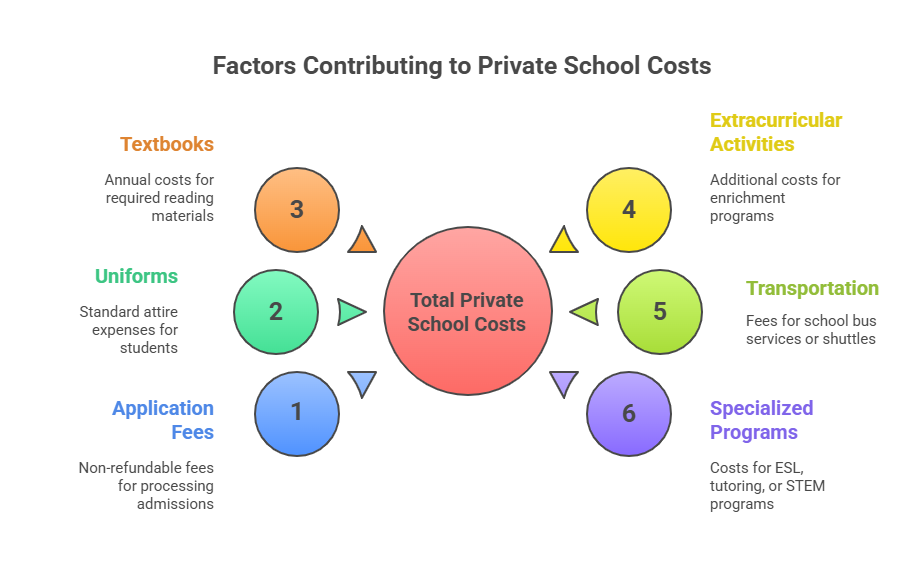How to pay for private school is one of the most common concerns for families pursuing quality education. Even though the smaller classes, advanced curriculum, and individualised learning are available in a more intimate environment, like in the case of private schools, the prices might be intimidating, particularly in cases where families feel they must take loans or tap their retirement funds.
Nevertheless, thousands of families in Canada and America manage to pay the tuition fees of the private institutions every year. The guide contains easy-to-follow, tested techniques on how you can pay tuition and fees without incurring a lot of debt. Since it includes tax credits, scholarships, monthly payment plans and work-trade programs, we cover all of them.
How to Pay for Private School: A Practical Guide for Parents
The increasing pricing in the education of private schools is nothing but a reality, and so are the alternatives. It does not matter whether you are a two-income family or a single parent; all Families that made less than 75K/year in 2024 received 40% in tuition relief through the XYZ Scholarship. This step-by-step guide looks at tools, schedules, and resources to enable you to craft a robust and cost-effective education plan for your child.
Understanding Private School Tuition & Fees
What Makes Up the Full Cost?
Most families focus on base tuition, but private school costs often include:
- Application & Registration Fees
These are typically non-refundable and can range from $50 to $500, covering the administrative costs of processing your child’s admission. Some elite schools may charge higher registration deposits to secure placement. - Uniforms and Classroom Supplies
Uniform costs add $300–$600 yearly—include gym wear and seasonal items especially when factoring in gym wear and seasonal items. Don’t forget classroom supplies like stationery, calculators, or school-branded materials. - Textbooks, Devices, and Tech Fees
While some schools lend textbooks, others require families to purchase them annually. Many also charge separate fees for tablets, laptops, digital learning tools, or bring-your-own-device (BYOD) programs. - Extracurricular Activities, Sports, and Field Trips
Enrichment programs such as music, theatre, robotics, or sports teams often carry extra costs. Field trips—especially overnight or international ones—can be a significant line item on your annual education budget. - After-School Care and Transportation
Extended care programs, bus services, and school shuttles typically come with additional fees. Depending on your schedule and commute, these services may be essential—and expensive. - Specialised Programs or Learning Support
If your child requires ESL support, tutoring, learning accommodations or attends an IB or STEM-intensive program, there may be added academic or administrative costs.
According to CAIS 2023 data, Canadian day school tuition ranges from $15,000 to $25,000/year, while boarding schools can reach $60,000+ annually.

Why Costs Vary by Region and School Type
Location, curriculum type (e.g., religious vs. independent), and facilities heavily influence tuition costs. For example, private high schools in Mississauga may cost more due to demand, while smaller faith-based schools may be more affordable. Families often ask how to pay for private school tuition without loans and the answer lies in scholarships, payment plans, and tax credits.
Hidden Costs: Uniforms, Tech & Extracurriculars
| Expense | Typical Range | Notes |
| Uniforms | $300–$600 | Required by many schools |
| Tech Fees | $250–$800 | Laptops, learning platforms |
| Books/Supplies | $200–$500 | Curriculum-specific needs |
| Clubs/Sports | $100–$1,000 | Optional but enriching |
| Transportation | $500–$1,200 | School buses, transit passes |
In addition to the tuition, there are many more costs in a private school that the family is unaware of. Most schools require uniforms, which cost as high as $600 a year. Additional costs of tech fees on tablets, laptops or electronic platforms can add up to an additional $ 200- $800. Extracurricular activities such as sports, music, or travelling abroad could also incur an excessive amount of your out-of-pocket costs in a year. Proper planning of such extras will make one restaurant’s budget realistic.
Budgeting Strategies: How to Afford Private School with Payment Plans
You don’t have to give a lump sum to manage tuition fees in private schools. Most schools also have monthly payment plans that allow payment of fees in bite-size snippets of 10-12 months. Automated savings, education-specific accounts and budgeting apps can also help families remain on track. A realistic financial plan on a white sheet gives you insight on how to avoid debt and keep your children’s education prospects within reach.
Tuition Payment Plans
Many private schools allow parents to pay monthly. Instead of a $20,000 lump sum, you might spread tuition across 10–12 equal payments-helping with cash flow.
Ask schools about:
- Automatic installment option
- Discounts for early/full payment
- Processing fees or third-party providers
Budgeting Without Loans
If you’re searching for how to pay for private school tuition without loans, start by:
- Automating deposits to a dedicated education account
- Cutting unnecessary monthly costs (e.g., subscriptions, dining out)
- Using year-end bonuses or tax refunds toward tuition
- Inviting grandparents to contribute to RESP or 529 plans
Expert Tip: “Start saving at least a year in advance and treat tuition like a recurring bill.” – Sarah Kim, CFP at Wealth Planning Group.
Scholarships, Grants & Tax Benefits
Learning fund private education with scholarships and grants can significantly reduce or even eliminate your tuition burden.
Scholarships and Grants: Reducing Tuition Costs
Here’s how to pay for private school with scholarships and grants:
- Need-Based Scholarships: For low-income families
- Merit-Based Awards: For academic, sports, or arts excellence
- Community-Funded Grants: Offered by nonprofits or churches
Application Timeline:
- Fall: Start gathering documents and researching programs
- Winter: Submit applications
- Spring: Interview or test, if needed
- Summer: Confirm enrollment with aid
Visit Our Kids Financial Aid Directory for school-specific scholarships in Canada.
Education Tax Benefits
Looking to reduce tuition through tax planning? Here’s how to pay for private school using tax benefits:
In Canada:
- Charitable Donation Tax Credits: Available if the school is a registered charity
- Disability Supports Dedication: For students with special needs.
- Manitoba’s Education Property Tax Credit now applies directly via tax returns; consult CRA for eligibility.(Source)
In the U.S.:
- 529 Plans: Up to $10,000/year for K–12 private school tuition (state rules vary)
- Covers childcare costs for children under 13, but not tuition itself (IRS §21).
- Refer to IRS Publication 970 for full tax details.
Expert Tip: “Claiming even one education-related credit can save hundreds. Check eligibility early.” – John Petros, CPA at Tax Advisory Group.
Creative Funding Options Families Overlook
Employer-Sponsored Benefits
If you’re wondering how to pay for private school using employer benefits, check if your company offers:
- Tuition reimbursement for dependents
- Education savings incentives
- Dependent Care Assistance Programs (DCAP)
Note: FSAs and DCAPs cover after-school care, but not tuition payments.
Crowdfunding & Community Support
Need free private school programs for low-income families? Many turn to community help:
- Crowdfunding (GoFundMe, GiveSendGo)
- Church or mosque sponsorship
- Education-focused nonprofits
Families with compelling stories (e.g., single parents, special needs, refugees) often succeed in raising partial or full tuition.
Work-Exchange or Volunteer Discounts
Looking for ways to send your child to private school without paying full tuition? Some schools offer tuition discounts in exchange for parent labour:
- Administrative: Filing, data entry, office assistance
- Facilities: Cleaning, repairs, gardening
- Event Support: Setups, chaperoning, organising drives
Case study: The Chen family reduced tuition by 40% through a janitorial work exchange program at their son’s school.
For Unique Family Situations
Single Parents
Here’s how to pay for private school as a single parent:
- Combine scholarships and grants
- Ask your employer about tuition benefits.
- Look for extended payment plans.
- Apply for hardship waivers from the school.
- Ask for multi-child discounts if applicable.e
If You Don’t Qualify for Aid
Need advice on how to pay for private school without financial aid?
- Apply for merit scholarships.
- Use monthly plans or an early-pay discount.s
- Launch a community campaign.
- Join cooperative schooling models
If You Have No Savings
Don’t panic. Here’s how to pay for private school fees without savings:
- Break tuition into monthly instalments. Most schools now allow tuition to be paid in monthly instalments, making it easier to manage how to pay for private school over time.
- Delay payment using enrollment grace periods
- Seek school-funded temporary hardship grants.
- Offset costs through employer education programs.
- Negotiate scholarships based on past performance
Loans vs. Payment Plans: Pros & Cons
Here’s a quick comparison of two common strategies:
| Factor | Education Loans | Monthly Payment Plans |
| Interest | Yes (5–9%) | No |
| Repayment Period | 3–10 years | Within the academic year |
| Credit Check | Required | Usually not |
| Flexibility | Moderate | High (custom plans available) |
| Risk | Long-term debt | None if payments are managed well |
Pro Tip: Always explore payment plans before applying for education loans.
Tools, Resources & Success Stories
Family Case Studies
1. The Singh Family – Brampton
Applied for an arts scholarship, combined with RESP withdrawals. Out-of-pocket cost: $0.
2. The Alvarez Family – Single Parent, No Savings
Crowdfunded $3,500 and received a religious sponsorship from their local parish.
3. The Wallace Family – Three Children in One School
Negotiated sibling discounts and worked 2-parent co-op shifts monthly to save $9,000/year.
Private School Funding Checklist
- Open an RESP or 529 plan
- Apply for at least 3 scholarships
- Explore your employer’s education benefits
- Review your province’s tax credits
- Request tuition instalment options
- Ask about volunteer or sibling discounts
- Build a tuition timeline 12 months in advance
Scholarship & Aid Directory
This article offers a complete step-by-step guide how to pay for private school fees through smart budgeting and financial tools.
- Children’s Scholarship Fund – Canada
- Our Kids Financial Aid Portal
- Ontario Independent Schools Assistance
- GoFundMe Education Campaigns
Conclusion
Affording private school is possible even for families without deep savings or access to loans. With the right mix of planning, research, and resourcefulness, you can give your child access to a high-quality education without compromising your financial future. From need-based scholarships and grants to monthly instalment plans, employer education benefits, and even tax strategies, today’s families have more options than ever before.
The key is to start early, stay organised, and explore every potential funding avenue because the path to private education isn’t reserved for the wealthy. It’s open to families who ask the right questions, apply early, and use tools like budget planners and school aid directories to stay informed.
Frequently Asked Questions About How to Pay for Private School
1. What happens if you don’t pay private school fees?
Late or missed payments may lead to financial penalties, including late fees or interest charges. In more serious cases, schools may withhold report cards, transcripts, or access to extracurricular activities. Continued non-payment can even result in dismissal or refusal of re-enrollment for the next term. However, many private schools have financial hardship assistance programs or flexible payment plans-so it’s always advisable to communicate with the administration before falling behind.
2. Why are private schools expensive?
Private schools generally operate without government subsidies, meaning tuition must cover all operating costs. These schools invest heavily in faculty-offering competitive salaries to attract experienced teachers-along with enhanced academic programs, smaller class sizes, and specialised extracurricular activities. Facilities like science labs, theatres, and athletic complexes also contribute to higher overheads. In return, students often receive a more tailored and enriched educational experience compared to what’s available in public systems.
3. What advantages do private schools offer?
Private schools often deliver a more personalised and rigorous academic environment. Benefits include low student-to-teacher ratios, specialised curricula (such as IB, AP, or arts-focused tracks), and a greater emphasis on holistic development. Many offer robust guidance counselling, international exposure, and leadership training. Discipline standards and community values are also emphasised. For children with unique learning styles or high aspirations, private schools can provide opportunities for growth that closely align with their strengths and goals.
4. Which one is better, a government school or a private school?
Neither system is universally better depends on your child’s needs, your location, and financial capacity. Public schools are free, widely accessible, and follow standardised curricula regulated by the government. Private schools, on the other hand, offer more control over curriculum design, learning pace, and student support. If your child thrives in small classes, structured environments, or specialised academic tracks, a private school might be a better fit. Evaluate both options based on values, academic goals, and resources.




